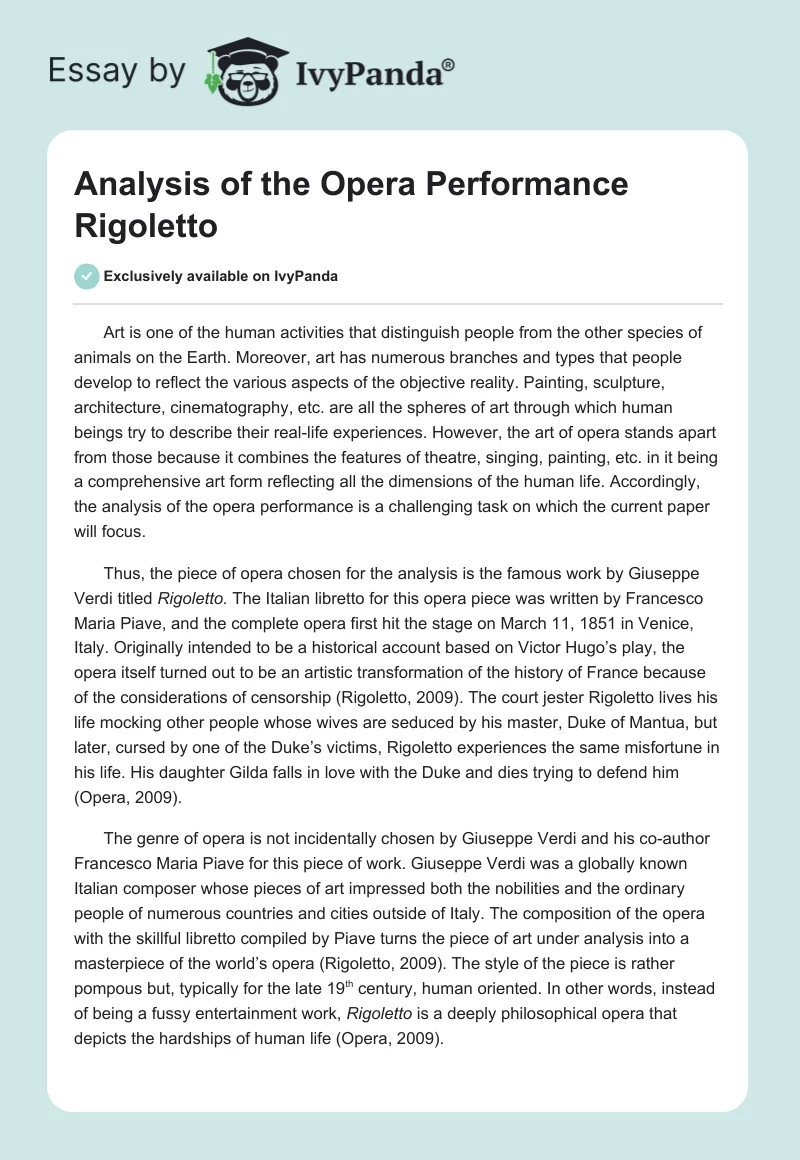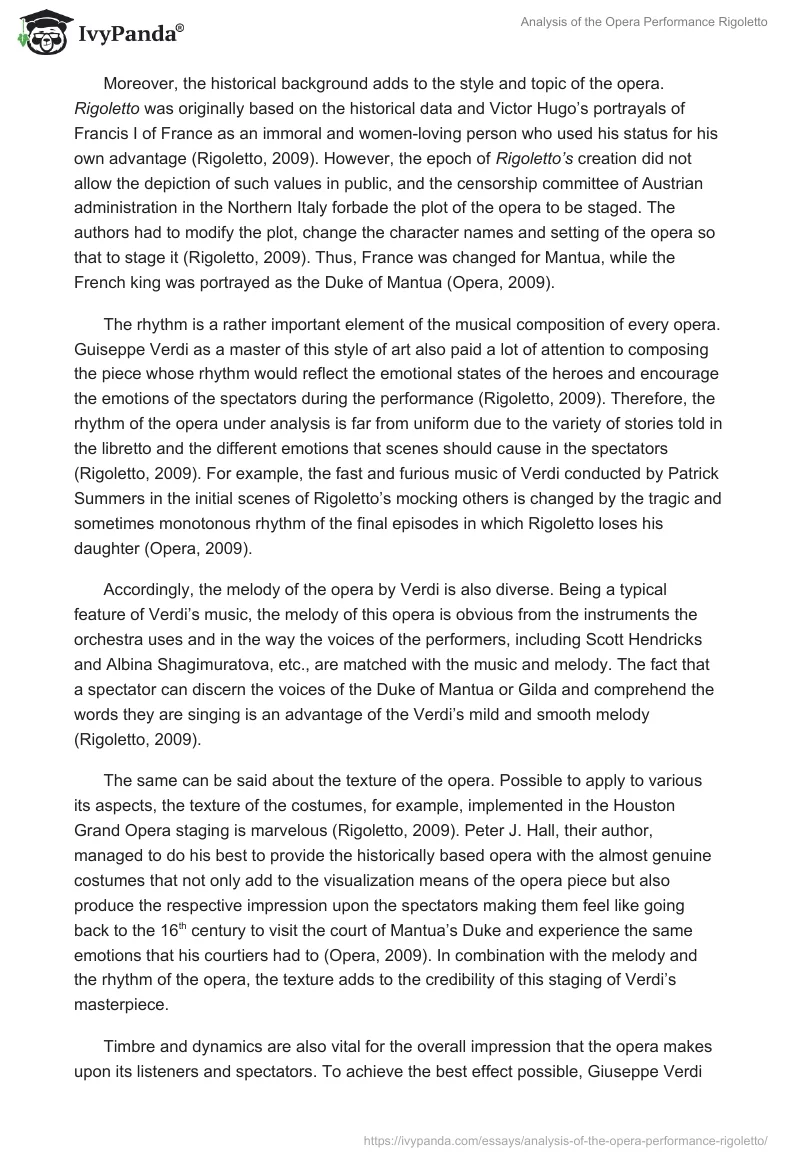Art is one of the human activities that distinguish people from the other species of animals on the Earth. Moreover, art has numerous branches and types that people develop to reflect the various aspects of the objective reality. Painting, sculpture, architecture, cinematography, etc. are all the spheres of art through which human beings try to describe their real-life experiences. However, the art of opera stands apart from those because it combines the features of theatre, singing, painting, etc. in it being a comprehensive art form reflecting all the dimensions of the human life. Accordingly, the analysis of the opera performance is a challenging task on which the current paper will focus.
Thus, the piece of opera chosen for the analysis is the famous work by Giuseppe Verdi titled Rigoletto. The Italian libretto for this opera piece was written by Francesco Maria Piave, and the complete opera first hit the stage on March 11, 1851 in Venice, Italy. Originally intended to be a historical account based on Victor Hugo’s play, the opera itself turned out to be an artistic transformation of the history of France because of the considerations of censorship (Rigoletto, 2009). The court jester Rigoletto lives his life mocking other people whose wives are seduced by his master, Duke of Mantua, but later, cursed by one of the Duke’s victims, Rigoletto experiences the same misfortune in his life. His daughter Gilda falls in love with the Duke and dies trying to defend him (Opera, 2009).
The genre of opera is not incidentally chosen by Giuseppe Verdi and his co-author Francesco Maria Piave for this piece of work. Giuseppe Verdi was a globally known Italian composer whose pieces of art impressed both the nobilities and the ordinary people of numerous countries and cities outside of Italy. The composition of the opera with the skillful libretto compiled by Piave turns the piece of art under analysis into a masterpiece of the world’s opera (Rigoletto, 2009). The style of the piece is rather pompous but, typically for the late 19th century, human oriented. In other words, instead of being a fussy entertainment work, Rigoletto is a deeply philosophical opera that depicts the hardships of human life (Opera, 2009).
Moreover, the historical background adds to the style and topic of the opera. Rigoletto was originally based on the historical data and Victor Hugo’s portrayals of Francis I of France as an immoral and women-loving person who used his status for his own advantage (Rigoletto, 2009). However, the epoch of Rigoletto’s creation did not allow the depiction of such values in public, and the censorship committee of Austrian administration in the Northern Italy forbade the plot of the opera to be staged. The authors had to modify the plot, change the character names and setting of the opera so that to stage it (Rigoletto, 2009). Thus, France was changed for Mantua, while the French king was portrayed as the Duke of Mantua (Opera, 2009).
The rhythm is a rather important element of the musical composition of every opera. Guiseppe Verdi as a master of this style of art also paid a lot of attention to composing the piece whose rhythm would reflect the emotional states of the heroes and encourage the emotions of the spectators during the performance (Rigoletto, 2009). Therefore, the rhythm of the opera under analysis is far from uniform due to the variety of stories told in the libretto and the different emotions that scenes should cause in the spectators (Rigoletto, 2009). For example, the fast and furious music of Verdi conducted by Patrick Summers in the initial scenes of Rigoletto’s mocking others is changed by the tragic and sometimes monotonous rhythm of the final episodes in which Rigoletto loses his daughter (Opera, 2009).
Accordingly, the melody of the opera by Verdi is also diverse. Being a typical feature of Verdi’s music, the melody of this opera is obvious from the instruments the orchestra uses and in the way the voices of the performers, including Scott Hendricks and Albina Shagimuratova, etc., are matched with the music and melody. The fact that a spectator can discern the voices of the Duke of Mantua or Gilda and comprehend the words they are singing is an advantage of the Verdi’s mild and smooth melody (Rigoletto, 2009).
The same can be said about the texture of the opera. Possible to apply to various its aspects, the texture of the costumes, for example, implemented in the Houston Grand Opera staging is marvelous (Rigoletto, 2009). Peter J. Hall, their author, managed to do his best to provide the historically based opera with the almost genuine costumes that not only add to the visualization means of the opera piece but also produce the respective impression upon the spectators making them feel like going back to the 16th century to visit the court of Mantua’s Duke and experience the same emotions that his courtiers had to (Opera, 2009). In combination with the melody and the rhythm of the opera, the texture adds to the credibility of this staging of Verdi’s masterpiece.
Timbre and dynamics are also vital for the overall impression that the opera makes upon its listeners and spectators. To achieve the best effect possible, Giuseppe Verdi made much effort to select the various voice types for performing this or that role (Rigoletto, 2009). The staging in the Houston Grand Opera also follows this tradition as the major parts in the opera are played by baritone Scott Hendricks in the role of Rigoletto, soprano Albina Shagimuratova, whose performance makes the listeners cry about the misfortune of Gilda, tenor Eric Cutler performing the Duke of Mantua, etc. Such a voice variety combined with the timely dynamics change and adjustments of the dynamic structure to the melody and rhythms comprises the basis for the opera’s artistic success (Rigoletto, 2009).
The combination of the above mentioned musical elements of the opera with the skillful performance of the actors and the proper work of the Houston Grand Opera team constitute the harmony of the opera (Rigoletto, 2009). Considering the mere artistic harmony of the opera, it is obvious that the libretto by Piave is a perfect match for Verdi’s music with its properly selected rhythm variations, dynamics changes, and melody and timbre compositions. Accompanied by the matching costumes, setting and the properly selected voice tones of the major performers, the staging by Lindy Hume and Michael Yeargan is one of the best variants of Rigoletto over the recent decades (Rigoletto, 2009).
Drawing from the above presented consideration of the musical characteristics of Rigoletto performed on May, 2, 2009 in Houston Grand Opera, I can now express my own ideas on understanding the music and the major ideas of the performance as such. First of all, the music by Verdi makes the strong impression on every listener by its high pitch and numerous timbre and melody variations. Listening to Rigoletto one seems to have experienced all the emotions of the characters through mere listening to the music. You don not even have to listen to the lyrics to understand the tragedy of the Duke’s jester and sympathize with him even after the opera ends (Opera, 2009).
As for the understanding of the performance, I think it is difficult to select the better cast of actors and singers to convey the meanings and messages that Verdi and Piave tried to in their joint work on Rigoletto. When one looks at the face of Scott Hendricks performing Rigoletto, one cannot but believe that this person knows what he sings about. The credibility of the performance is one of the aspects that contribute to the overall positive public acceptance of the opera as staged in Houston Grand Opera. Thus, the opera Rigoletto has changed my understanding of art on the whole and of the meaning of this piece of Verdi’s work in particular. It is now evident for me that apart from being a work of entertainment, Rigoletto is a philosophical work helping people cope with the issues in life.
To conclude, it is necessary to state that the art of opera stands apart from those because it combines the features of theatre, singing, painting, etc. in it, being a comprehensive art form reflecting all the dimensions of the human life. Rigoletto by Giuseppe Verdi is one of the brightest examples of opera masterpieces being, besides, a philosophical work touching the topics of love and hate, life and death.
Works Cited
Opera. Stanford Education. 2009. Web.
Rigoletto. Houston Grand Opera. 2009. Web.


